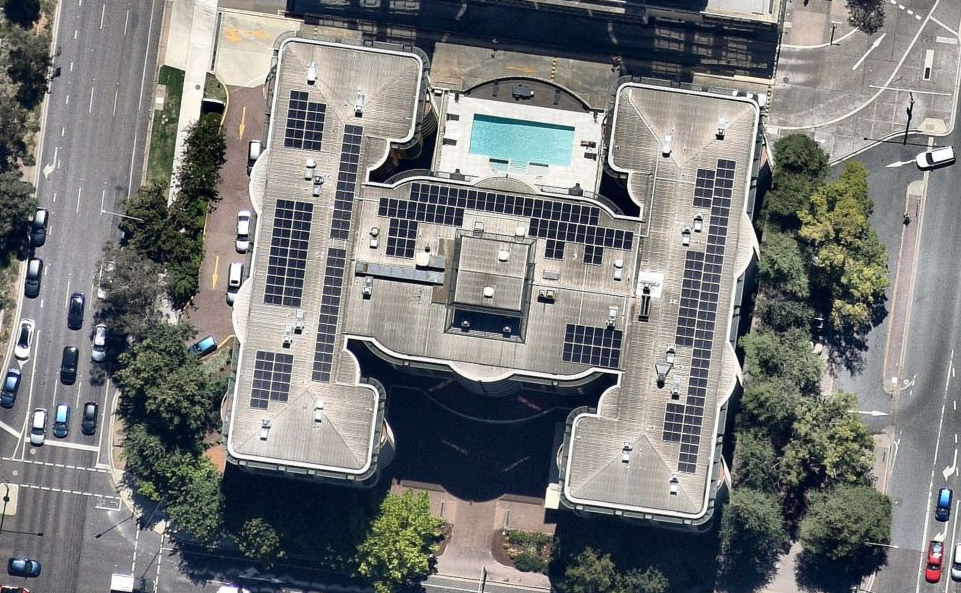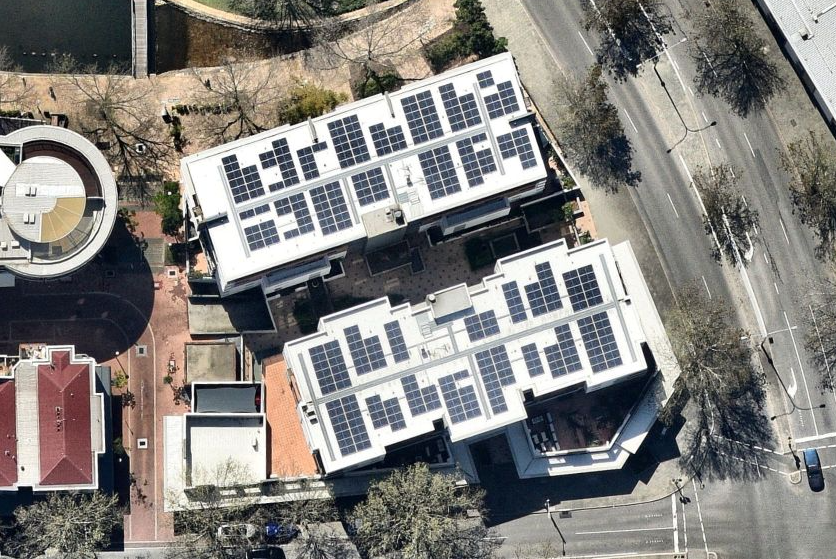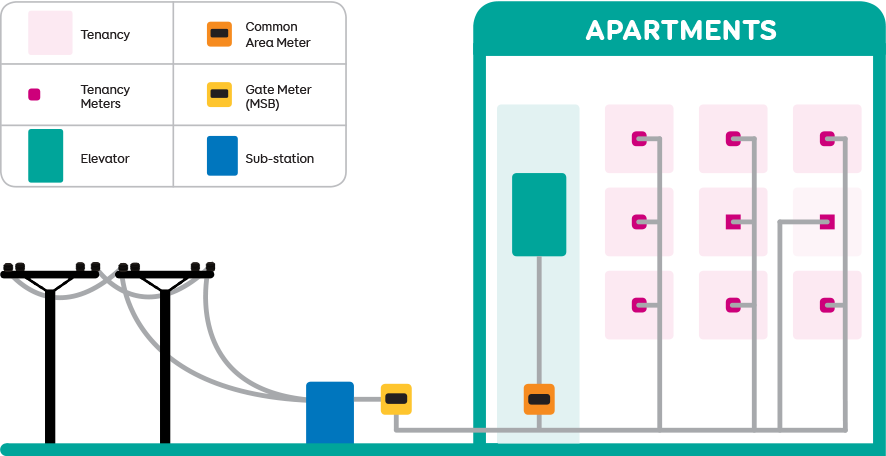Strata apartment buildings are one of the final frontiers for rooftop solar. Apartment solar projects are necessarily complex, but there are now a number of available solutions that can help solve the specific challenges. Solar Choice specialises in designing the optimal options for solar power on strata buildings and helping committee members navigate all the way through the procurement, consultation and voting challenges to installation.
New NSW Solar for Apartment Residents Grant (2025)
New in 2025: The Solar for Apartment Residents Grant provides $25 million in funding, with up to $150,000 per project, covering 50% of the cost of shared rooftop solar PV systems.
Applications Open Now | Deadline: December 1, 2025 (or until funds run out)
Solar for strata is tricky: Here’s why
If you’re looking into solar for a strata building, it’s important that you understand the challenges that you’re up against – and the experiences that a lot of solar companies have in implementing solar for strata properties.
- Where the roof area to be used is common property (in most cases) then a special resolution is required to pass a new by-law. This requires a 75% vote, or in NSW the state government has just reduced this to 50%. As this needs to be done at an EGM, the decision-making and approval process is usually quite slow for these projects
- There are usually additional costs to install solar on strata buildings:
- Flat and concrete roofs will mean additional equipment is required to ballast and tilt the solar panels
- Tall buildings might require crane hire and traffic control from the local council
- If there isn’t space in existing electrical risers (cable conduit that travels vertically up a building) then there could be an extra long cable run or some costs to drill a core hole through the floors
- If you want to tackle the electricity bill from your individual unit you will need to equitably divide the roof space or install a system that shares power between the units that want to participate
- There is often a mix of renters and owner-occupiers in a strata complex. The incentives for getting solar differ depending on which you happen to be. If a landlord with renters wish to invest in solar then they may need to reach an agreement with tenants to increase rent payments before participating
Talk to an experienced Solar Choice consultant about options for your Strata Building
There are 4 options to install solar power on strata buildings
With these complications in mind, here are four potential solutions to the ‘solar on strata buildings’ problem – from most straightforward & simple to most technologically sophisticated & complex.
Option 1: Solar for the common areas
Each strata building has a dedicated meter for the common areas, where lights, lifts and other communal equipment run; the electricity bill associated with this meter is paid for out of strata levies. For very tall apartment blocks with limited roof space this is the simplest option to install solar as it is a communal cost and everyone will (or should) benefit equally from it in the form of reduced strata bills. Furthermore, the capital expenditure required to purchase such a system can be relatively small, especially if the strata building does not have any communal lifts, air conditioning, pools or other devices which use a large amount of electricity.
Main advantages:
- Relative simplicity, with one solar PV system behind just the common area meter
- All owners benefit equally through reduced common costs (usually covered by strata levies)
- Extra power on the common area meter can be useful for Electric Vehicle Charging
Main disadvantage:
- No savings on electricity bills for individual occupants
When getting quotes for your strata committee it is important to find installers with experience installer on high-rises and concrete roof-spaces. Solar Choice has a network of installers, and we can help you find the local options with the right experience.

Option 2: Each unit gets a separately-metered solar system
Under this option each owner would get their own solar system and would be allocated part of the roof space. For the most part, this option is usually only taken up by townhouses where units have their own roof space or very small apartment buildings where owners can work through roof space allocation collectively.
In this case, in the name of ‘fair share’, it makes sense for the solar-friendly (i.e. unshaded and north/west/east-facing) sections of roof to be pre-emptively divided up between all the owners. This could turn out to be complicated, especially if the roof is multi-faceted and has shading issues in more than one place. If the strata building has a section of roof with full and equal solar access, this challenge should be relatively clear-cut and easy to solve.
If your strata committee gets to this point, you’ll then need to work out how much each section of roof area will translate into in terms of solar panel capacity. In the end, each system may be quite small (1.5kW–2kW), especially if the building is more than 2-3 stories tall and there’s significantly more floor area than there is roof area. In either case, the most financially sensible approach may be to have all the solar systems installed at the same time and by the same company, as smaller systems tend to be more expensive per watt of capacity than larger ones, and the way to bring down the overall cost would probably be a bulk buy.
Main advantages:
- Provided there is ample viable roof space to go around, each unit has its own solar system, wired up to their own individual meter. This means that there’s no question of whether the benefits of the solar are being shared around in an equitable way, as actual savings will come down to how individuals use energy throughout the day.
- Each unit may have the option to own their solar PV system separately
Main disadvantages:
- Difficult to fairly allocate available roof area between units and have all owners agree
- As the individual systems will be small and wired up individually, they are additional cabling costs and a requirement to find space on the wall for each owner to have a solar inverter installed
- If everyone doesn’t go ahead at the same time, these projects often lead to first in best dressed in terms of roof space, installations costs (due to easy cable pathways and solar inverter location) and switchboard works

Shared solar systems split one large system into multiple meters. At the time of writing this article, there is only one company (that we are aware of) in Australia with the technology to deliver it. Allume Energy with its SolShare solution have solved a number of the issues outlined at the top of this article.
The SolShare solution is essentially a smart diverter that enables solar energy from a single rooftop solar system to be shared between multiple apartments within the same building. To make the system as efficient as possible but also fair, the SolShare delivers the same amount of solar energy to each apartment over the course of a month but supplies it when it’s needed by each unit.
How the Allume Energy SolShare program works. (Image via Allume Energy.)
In addition, the technology incorporates energy monitoring software, so that you know how much electricity you’re using throughout the day and when solar energy’s available.
Main advantages:
- Any metered unit can be connected, including common light and power.
- Units can opt out if they don’t want to be connected (although it can be a complex process to get by-law approval and administration sorted when everyone doesn’t participate)
- The system is bought by the owner’s corporation, removing complications around individual roof space ownership.
- No changes to existing metering infrastructure is required – everyone retains their right to choose their electricity retailer.
Main disadvantages:
- The Allume solution comes at an additional upfront cost to a traditional solar system
- Requires a minimum of 6 units
- Whether the Allume system is a financially attractive project is case-by-case, depending on the number of units, available roof space and space requirements to install required infrastructure

Find out whether your apartment building is suitable for Allume’s solution
Option 4: Single system with embedded network
If your building is not set up on an embedded network already, then this approach is the most complex, difficult, and potentially costly of all the options listed here. An embedded network is basically a private ‘microgrid’ within a strata building. Every unit is metered separately behind a ‘master’ meter that connects the building to the grid. Individual units in an embedded network are generally promised cheaper rates for their electricity, regardless of whether there is solar or not.
In instances where solar is installed on an embedded network, the energy produced can theoretically be ‘split up’ equitably among units. Even feed-in credits could be split up among different units. Legally, residents of individual units would still have their choice of electricity retailer (if they live somewhere with a competitive market).
While the embedded network solution is the most ‘thorough’ of those listed here, it is also the most fraught with complications and the most difficult to implement – especially for existing buildings where an embedded network would need to be retrofitted. The first hurdle is getting agreement would be the strata committee, where a unanimous vote would be required in order to take any action. Given the potentially large costs and a broad variety of approaches, there’s a considerable chance that the project would never get past initial committee discussions without some serious dedication on the part of its members.
Another important challenge is the requirement to get approval from the Embedded Network Manager (ENM). In the National Electricity Market (NEM), every embedded network needs to have a registered manager, due to Power of Choice regulations. The ENM is not incentivised to allow the Body Corporate to install solar as it means they are drawing less power through their gate meter and selling less power to the residents. Solar would also mean a change in the ENM’s billing system which would be difficult to negotiate.
Diagram of an embedded network. (Image via MyComm Energy.)
Main advantages:
- Potentially the most equitable and simple way to supply solar energy to units in a strata building that also helps to deliver the full potential value of solar energy (i.e. ‘free’ solar energy to be consumed during the day, plus solar feed-in credits)
- An embedded network is usually designed to deliver a better electricity rate than the owner could find on the open market
Main disadvantages:
- Could be prohibitively costly to implement – especially if applied as a retrofit solution instead of as part of a new development
- A wide range of suppliers and specific approaches could make it difficult or time-consuming for strata committees to decide on the one that best suits their situation and needs, or to get a unanimous agreement about the best approach among committee members
- Owners retain a legal right to opt out of the embedded network (even if they are on a better deal) which can create complexity
- Usually only an option for bigger residential blocks with 50+ units

Investigating solar for your strata building: Next steps
Now that you know your options, there is the question of which one is most appropriate for your situation. Solar Choice manages tenders for a wide range of solar projects – including apartment buildings – and is happy to have a no-obligation chat. Get in touch today to learn more about receiving a Business Case Analysis & indicative Quote Comparison of leading solar installation companies in your area.
Request a free solar business case and compare leading commercial installers
Can you install solar panels on an apartment building in Australia?
How does solar work for strata apartments?
What is the best solar option for apartment buildings?
What are the costs of installing solar in an apartment building?
Can renters benefit from solar in apartments?
Can apartments claim feed-in tariffs for excess solar power?
How do strata committees approve solar installations?
Is solar worth it for apartments?
What’s the best next step for installing solar in an apartment complex?
- Why a big battery could be cheaper than a small battery with the federal rebate? - 19 June, 2025
- Heat Pump Costs – Solar Choice Price Index - 1 June, 2025
- Solar Panel Costs: Solar Choice Price Index | July 2025 - 1 June, 2025


